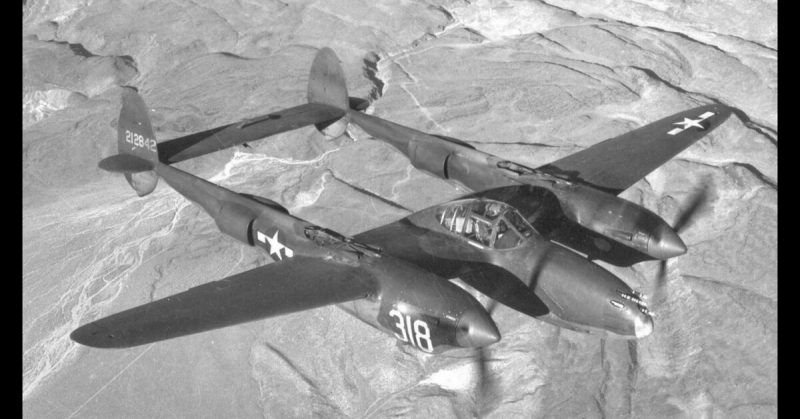P-38G-10-LO Lightning (SN 42-13400) is a warplane built by the Lockheed Aircraft Corporation during World War II and delivered to the US Army for use in the US Army Air Force. The plane was assigned Nose Number 95 and was used by the 54th Fighter Squadron in training in the Aleutian Islands of Alaska.
The P-38 Lightning did not look like other planes of the time, as its two tails were a unique feature. Less than six months after being placed into active duty, a hysterical German pilot was captured in North Africa. He kept pointing to the sky and exclaiming, “der Gableschwanz Teufl.” Because of this, the Lightning gained the nickname, “the fork-tailed devil.”
Sleek and fast, she could climb to 3,300 feet in one minute. She was 100 MPH faster than any other plane. The P-38 could carry a larger cargo than the early B-17s. She had a range of 1,150 miles, and her nose-mounted machine guns could fire 409 rounds a minute.
P-38s were known to be able to sink ships. They could strafe the ground and destroy tanks. They were used to shoot down enemy planes and blow up enemy pillboxes. Ninety percent of the reconnaissance film captured in Europe was obtained by P-38s. They were the planes sent on a 1,000-mile mission to attack Japanese Admiral Isoroku Yamamoto when code breakers discovered he was making an inspection flight in the Pacific. That mission led to the successful capture of the admiral, breaking Japanese morale and hastening the end of the war.
2nd Lt. Robert L. Nesmith was flying this particular plane in a training mission with three other Lightnings on January 1, 1945. During the flight, he came too close to the ground and overcorrected when he tried to increase his altitude. The starboard engine touched the ground, and the propeller was ripped from the plane as it rose.
Nesmith was able to glide the plane to a smooth landing at which point he ran from the plane in case it exploded. He was rescued and returned to duty with no injuries.
The plane remained at that spot for over fifty years. The tips of the wings, the propellers, and the guns were removed, and the instruments were taken from the cockpit. Someone must have used the stabilizers for target practice at some point as they had bullet holes in them.
In 1979, the Alaska Aviation Heritage Museum’s Ted Spencer nominated the plane to the National Register of Historic Places. It is the only known example of a P-38 Lightning left in the world.
In 1999, the plane was moved to the Elmendorf Air Force Base. It was registered as N55929 and restored over the next six months. In 2000, the plane was placed in McCloud Memorial Park for display.
In 2016, the Aircraft Structural Maintenance unit with the 3rd Maintenance Squadron of the Air Force began a year-long project to restore the plane as close to the original design as they could. They began by stripping the plane and documenting the parts. They then sanded and washed the parts before priming and painting it.
The painting proved especially difficult to the team. Tech Sgt. Matt Monnens, the 3rd MXS aircraft structural maintenance chief lead, explained that the Air Force now uses flat paint, but they used high gloss paint during the war. That led to difficulties in precisely matching the original color of the plane. High gloss paint also meant that they had to be extra precise with the work they did because the paint would not hide mistakes like a flat paint can. The plane was originally painted in a two-tone scheme that was not easy to match in the new paint job.
In the end, over thirty airmen worked on the project and successfully restored the plane to its former glory.
On August 26th, 2017, the result of their hard work and attention to detail was returned to the Air Force base and placed back on display.
She may no longer be able to fly, but this P-38 is looking just as good in her 70s as she did when she was new.
